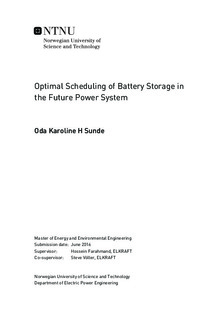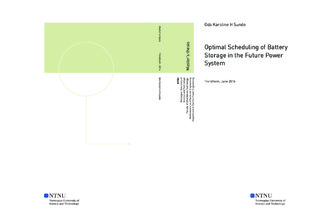| dc.description.abstract | This research work has resulted in an optimisation strategy for operation of batteries in a power system. The model is formulated as a mixed integer linear program constrained by power system limitations on transmission capacities, production limits and PTDFs, and battery limitations on power/energy capacities and efficiency. In the work with the development of the optimisation strategy, two separate models is created. The first model is for optimisation of a power system determining the power production and power flow, based on the FBMC technology. The second model is for optimisation of battery dispatch with respect to the time for ant amount of charged and discharged power. The two models are merged and the result is the final optimisation model for operation of batteries in a power system. The formulation of the MILP is implemented in the modelling system GAMS, which is the program used to perform the optimisations.
The purpose of this research work is to study the impact of optimal scheduling of battery storage in a power system. An aggregated model of the Norwegian power system comprising of 22 buses and 33 lines is used. Discussion of the accuracy of the aggregated Norwegian power system relative to the real power flow situation is included. The formulation of the battery model is performed through the analyses on three different scenarios, to ensure properly behaviour. Verifications of the validity of the three scenarios are performed.
Scheduling of optimal battery dispatch using the established optimisation model and an aggregated model of the Norwegian power system is performed through seven case studies. The cases are constructed to investigate the behaviour of batteries in situations including large variations in day-ahead prices, congestion situations and planned generation outages. Moreover, analyses on two cases addressing a fictive future solar power scenario are performed.
The objective of the optimisation model is to minimise the total system operating costs, meaning costs for hydro production and battery operation. In the case studies, the exogenous electricity prices from the electricity market are used as marginal costs for hydro power production, and the charging costs and discharging earnings are set to the average electricity price. The batteries do not participate in the electricity market and are considered as price-takers. For the scope of the case studies, the batteries do not generate any additional income, but are assumed to be included in the grid to be able to provide services.
The results from the case studies show that the total system operating costs are decreased in all situations when including a battery to the power system. The performed cost-benefit analysis states that a battery investment of 50MW/200MWh will not be profitable for these optimisation scenarios. The total system operating cost reduction increases with increased volatility in the day-ahead price over a day. The charging pattern is strictly dependent on the day-ahead price, and will not deviate from the optimal pattern unless limitations are given, or the network reaches its limit and the battery has to change the dispatch to help the system operate. It is also shown that batteries can help the system through transmission congestion and generation outages. The cases with solar polar power reduces the total system operating costs due to the decreased hydro power production requirement. In addition, revenue to the solar panel owners from selling energy to the grid and from production shifting by use of the solar panel owner's batteries give decreased total system operating costs.
It is assumed that the established model can be used by hydro power producers to schedule their production and by battery owners to schedule their desired charging pattern. | |

